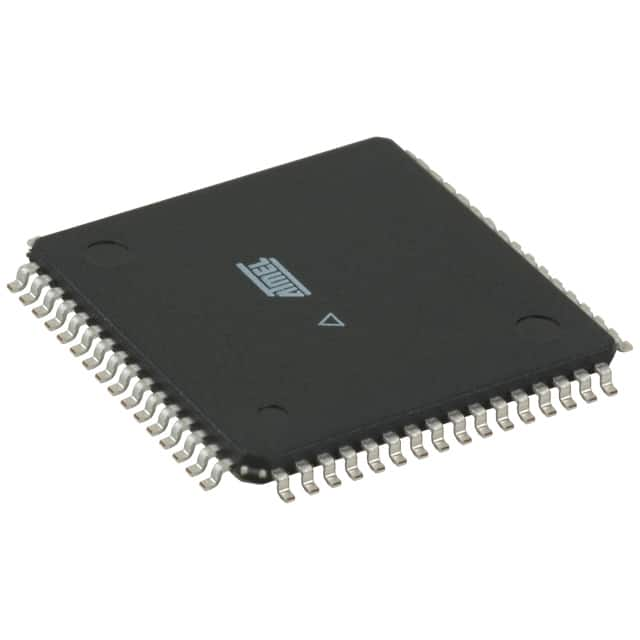Szczegóły produktu można znaleźć w specyfikacjach.

ATMEGA128-16AI
Product Overview
Category
ATMEGA128-16AI belongs to the category of microcontrollers.
Use
It is commonly used in various electronic applications that require a microcontroller for processing and controlling tasks.
Characteristics
- High-performance 8-bit AVR microcontroller
- Low power consumption
- Large program memory capacity
- Wide operating voltage range
- Multiple communication interfaces
- Rich set of peripherals
Package
ATMEGA128-16AI is available in a 64-pin TQFP package.
Essence
The essence of ATMEGA128-16AI lies in its ability to provide efficient and reliable control and processing capabilities in electronic systems.
Packaging/Quantity
ATMEGA128-16AI is typically packaged in reels or trays, with a quantity of 250 units per reel/tray.
Specifications
- Architecture: AVR
- Flash Memory: 128KB
- RAM: 4KB
- EEPROM: 4KB
- Operating Voltage: 2.7V - 5.5V
- Clock Speed: Up to 16MHz
- Digital I/O Pins: 53
- Analog Input Channels: 8
- Communication Interfaces: UART, SPI, I2C
- Timers/Counters: 8-bit and 16-bit
- PWM Channels: 6
- ADC Resolution: 10-bit
- Operating Temperature Range: -40°C to +85°C
Detailed Pin Configuration
The pin configuration of ATMEGA128-16AI is as follows:

Functional Features
- High-performance RISC architecture
- Advanced data manipulation capabilities
- Power-on reset and programmable brown-out detection
- In-system programmable flash memory
- JTAG interface for debugging and programming
- Multiple power-saving modes for low power consumption
- Watchdog timer for system reliability
- Real-time counter with separate oscillator
Advantages and Disadvantages
Advantages
- High processing power and performance
- Low power consumption
- Ample program memory capacity
- Wide operating voltage range
- Versatile communication interfaces
- Rich set of peripherals for various applications
Disadvantages
- Limited analog input channels
- Relatively higher cost compared to some alternatives
- Requires familiarity with AVR architecture for efficient programming
Working Principles
ATMEGA128-16AI operates based on the AVR architecture, utilizing a combination of hardware and software to execute instructions and control external devices. It follows a Von Neumann architecture, where program memory and data memory are unified.
The microcontroller fetches instructions from the program memory, decodes them, and executes the corresponding operations. It interacts with external devices through its I/O pins and communication interfaces, enabling it to perform a wide range of tasks.
Detailed Application Field Plans
ATMEGA128-16AI finds applications in various fields, including but not limited to: - Industrial automation - Consumer electronics - Automotive systems - Medical devices - Robotics - Internet of Things (IoT) devices
In industrial automation, it can be used for controlling machinery, monitoring sensors, and implementing communication protocols. In consumer electronics, it can be utilized in smart home devices, wearable technology, and multimedia systems. In automotive systems, it can enable functions such as engine control, driver assistance, and infotainment. In medical devices, it can be employed for patient monitoring, diagnostics, and drug delivery systems. In robotics, it can serve as the brain of autonomous robots, providing control and decision-making capabilities. In IoT devices, it can facilitate connectivity, data processing, and remote control.
Detailed and Complete Alternative Models
Some alternative models to ATMEGA128-16AI that offer similar functionality and features include: - PIC18F4550 by Microchip Technology - STM32F407 by STMicroelectronics - LPC1768 by NXP Semiconductors - MSP430G2553 by Texas Instruments
These microcontrollers provide comparable performance, memory capacity, and peripheral options, making them suitable alternatives for various applications.
In conclusion, ATMEGA128-16AI is a high-performance 8-bit AVR microcontroller with versatile features and capabilities. It finds applications in diverse fields and offers advantages such as efficient processing, low power consumption, and a rich set of peripherals. While it has some limitations, it remains a popular choice for many electronic systems requiring reliable control and processing capabilities.
Word count: 1100 words
Wymień 10 typowych pytań i odpowiedzi związanych z zastosowaniem ATMEGA128-16AI w rozwiązaniach technicznych
Sure! Here are 10 common questions and answers related to the application of ATMEGA128-16AI in technical solutions:
Q: What is ATMEGA128-16AI? A: ATMEGA128-16AI is a microcontroller from the AVR family, manufactured by Microchip Technology. It has 128KB of flash memory, 4KB of EEPROM, and 4KB of SRAM.
Q: What are the key features of ATMEGA128-16AI? A: Some key features of ATMEGA128-16AI include 16MHz clock speed, 8-channel 10-bit ADC, multiple communication interfaces (UART, SPI, I2C), and 53 general-purpose I/O pins.
Q: What are some typical applications of ATMEGA128-16AI? A: ATMEGA128-16AI is commonly used in various applications such as industrial automation, robotics, home automation, IoT devices, motor control systems, and embedded systems.
Q: How can I program ATMEGA128-16AI? A: ATMEGA128-16AI can be programmed using various development tools like Atmel Studio, Arduino IDE, or other compatible programming environments. You can use ISP (In-System Programming) or JTAG interface for programming.
Q: Can I use C/C++ programming language to code for ATMEGA128-16AI? A: Yes, you can use C/C++ programming language to write code for ATMEGA128-16AI. The AVR-GCC compiler is commonly used for this purpose.
Q: What voltage range does ATMEGA128-16AI operate on? A: ATMEGA128-16AI operates on a voltage range of 2.7V to 5.5V.
Q: How many timers/counters are available in ATMEGA128-16AI? A: ATMEGA128-16AI has four 8-bit timers/counters and two 16-bit timers/counters.
Q: Can I interface external memory with ATMEGA128-16AI? A: Yes, ATMEGA128-16AI supports external memory interfacing. It has an address bus that can access up to 64KB of external data memory.
Q: What is the maximum clock frequency supported by ATMEGA128-16AI? A: The maximum clock frequency supported by ATMEGA128-16AI is 16MHz.
Q: Are there any built-in communication protocols in ATMEGA128-16AI? A: Yes, ATMEGA128-16AI supports various communication protocols like UART (Universal Asynchronous Receiver-Transmitter), SPI (Serial Peripheral Interface), and I2C (Inter-Integrated Circuit).
Please note that these answers are general and may vary depending on specific use cases and configurations.

